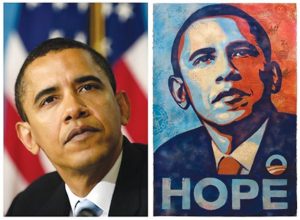11 5.8 Understanding Fair Use
Fair use refers to specific legal exceptions to copyright restrictions that allow copyrighted material to be used in certain ways without having to ask for permission or pay any fees. One reason fair use exists is to make it easier for copyrighted material to be used in universities and other educational settings. We need to use others’ works in education because we comment on them, teach them, make copies of them for classroom use, and use them in our research. Outside of the classroom, fair use is often cited when a visual or musical artist reuses a reference or other piece of art in their own work (e.g. Andy Warhol).
In one example, graphic designer Shepard Fairey based his well-known “Hope” poster on a photograph of Barack Obama that was taken by photographer Mannie García, who was working for the Associated Press (AP).[1]

Fairey did not acknowledge the source of his derivative work. When the source was revealed, Fairey tried to defend his work as fair use. When the AP took Fairey to court for copyright infringement, a judge decided Fairey’s use was not transformative enough and thus not fair use. In addition, since the original was not cited or acknowledged, it would be difficult to consider Fairey’s work as commentary or critique of the original. Below, we review the four factors for determining fair use and how Fairey’s work fails to meet them.
Purpose and Character of the Use
This factor considers what you’ll be doing with the work.
- Are you going to use it in its entirety “as is”, or are you going to transform it somehow?
- Will that transformation radically and significantly change it from the original?
- Will you provide some kind of commentary or critique or parody?
- Have you added new meaning or new value through your use?
- Are you going to be using the content to teach or learn?
In the case of the “Hope” poster, the graphic designer attempted to transform the photograph by color blocking sections of the picture; however, they did not significantly transform the photo from the original.
Nature of the Copyrighted Work
Fair use is more likely to support the use of scientific material rather than original, creative works.
- Is the work you are using completely original, and unique to the work’s creator, or something that has been done before?
- Is the work intended to be used/consumed, such as a workbook, or used over time, like a book?
Using someone else’s creative work, such as Mannie García’s photograph, is less likely to be considered fair use. Copyright law was created to protect authors so that they would create more. Mannie García’s photograph was his own creative expression, another reason why the judge determined Fairey’s derivative poster was not fair use.
Amount and Substantiality
Fair use supports the use of a small or less important portion of a work.
- How much of the work will be used, all or part?
- How important to the original is the part you’re using? Is it an essential piece?
It appears that Mannie García’s entire photo was used. Again, this leans against fair use.
Effect upon Work’s Value
Fair use supports a reuse that does not negatively impact the market for the original work.
- Will use of the work mean fewer people will buy the original?
- Will people not even recognize the original work as the originating work?
- Will the original work be mistaken as a derivative work, or even ignored?
The photograph in this example was Mannie García’s original creation. However, Shepard Fairey’s derivative work became so famous that most people would never know the poster was based on someone else’s work. In other words, you could say that Mannie García’s photograph and creative vision was devalued.
As we’ve seen in this example, fair use is determined by considering not one or two but all four factors. One common misconception is that everything is fair use if the material is used for an educational purpose. That’s an oversimplification. There are four key factors that serve as guidelines for determining when a use can be considered fair use.
Fair Use and Classroom Use
Before we move on, let’s do a quick review and contrast the “Hope” poster example to the typical classroom use or the use of copyrighted images in course materials such as ours. Teachers use a lot of graphics in their course materials to illustrate concepts and content being taught in their courses, often putting graphics in a new context or combining them in collages and creating something new. That use is probably not detracting from the value of the original. Most importantly, many materials like these are available only to students enrolled in a class, not published, distributed, sold, or posted on a website anyone anywhere can access. All this builds a strong argument for fair use.
- Ethics in Graphic Design, http://www.ethicsingraphicdesign.org/test-for-legalities/ and Wikipedia https://en.wikipedia.org/wiki/Barack_Obama_"Hope"_poster ↵
